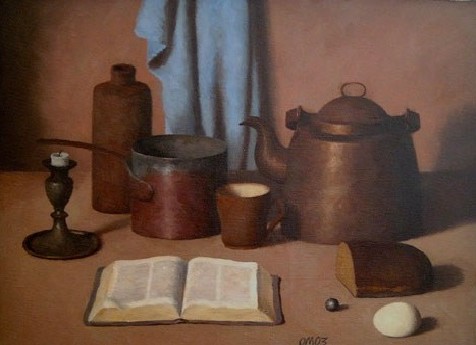The umber silhouette of the Old Town on the background of a mustard sunset on one side, and the white, antique and utopian mass of stone against a bright blue sky on the other, separated by a colourful barrier, the summery meadow, an abstraction that fascinated and engrossed me for days.
It was Plato’s cave that I envisioned. The main theme in the work of Plato is the teachings of an idea, the counterposition of an idea and the apparent reality, that he illustrates with his cave myth. Sitting at the opening to the cave, we see shadows on the wall of the cave, cast by objects from behind us. We take these distorted images as the truth, without seeing the reality. If the shadow on the wall of the cave is just deception, then the artist displaying the shadows in their works, according to Plato, practices double deception. Plato deems art that imitates visible objects as mere handicraft.
Such pessimism was what brought me to the question of whether and how it is possible to express a shapeless and bodiless idea with art, from where it is found, and how it is seen. In the biographical book published for the anniversary of the birth of Olev Subbi, the grandmaster says:
“In his first independent works, the artist uses ideas that have been waiting for a long time. These are often the best ones. From then on, the tiredness of ideas must be compensated by the mastering of the skill. Unfortunately, in the end it will not be enough either.”
Subbi found that art and life can be modelled after one another. So, the resolution of the more complicated problems in life and art is similar. In the interview with Enn Põldroos published in the same book, he adds explicitly, how artists are, or at least should be, both philosophers and craftsmen at the same time. When talking about the work of colleagues, Subbi stops at the form, or the side of the craftsmanship, yet actually searches for the person and personality that can be sensed behind the pictures. The juxtaposition of the content and the form clearly has a presence in the work and thought process of Subbi, just like the question of the illusionary and the ideal world. Someone over the rainbow knows...
Almost half a century ago, at the exhibition in Tartu Art Hall, Olav Maran was displayed side-by-side with Subbi and Põldroos. The exhibition was described as follows: “the works of all three artists are characterised by the search for new ways of expression, the strive to dig deep into the nature of phenomena for the work to become rich in thought and provoking it in the spectator.“
The still lives of Olav Maran are fit to be a dialogue partner for Subbi. Lights and shadows. Subbi and Maran are both characterised by the juxtaposition of the bold and the graceful. Maran’s amaryllises and Subbi’s amaryllises. Two calculated compositions, where every shadow in a crease of cloth and each inanimate object speaks within itself, yet creates an ensemble together with others.
If Subbi’s favourite characters are wide-striped tablecloths, bottles of red wine and candlesticks, then Maran’s recurring heroes are napkins, milk jugs and teapots, garden crops and eggs. When compared to the bright and clear colours of Subbi, the palette of Maran’s still lives takes a bronze hue. The dark tranquillity of the blues, yellows and reds adds movement, which is finished off by the eggshell white oval, just like the pearl earring worn by the girl in the portrait by Vermeer.
The realistic, tangible nature of the earthly crops painted in immaculate detail like the Dutch Golden Age painters did, is what Plato would have probably despised – the shadows within ourselves. We understand things on such a level as they seem to us, depict them as we sense them. Objects in the paintings and in life soon become fetishes, making us ask what is behind them. The still-lives of both artists can be seen as masterful compositions, quiet meditations as the gates to one’s internal landscape, on the level of ideas, thoughts, feelings.
If Subbi’s still lives are fit to depict the lunch of a slightly romantic, spirited and easy-going city dweller, then Maran opposes this idea with a contemplative, peaceful and slightly heavy scene of a rural household. In both cases the nostalgic everyday objects simply take the key role in guiding us through the gate, on one side of which is the dawn, and, on the other, dusk. While in Subbi’s scene, the candle has not yet been lit, Maran’s has already burned out.
“The myth of the cave is understood incorrectly, when speaking about the shadow, the objects and the fire. The only thing that matters is the sun, and if the fire is necessary at all, then only for grabbing a smouldering log to make everyone rush out of the cave to live and die by the sun, the true source of light.” This is what someone once thought about Plato and his cave. This philosophy has intrigued many.
A consistent effort to capture something ethereal though the mundane and the inextinguishable passion to decode what was captured is something life in art gives permission to.
.png)
